Your Nissan Altima’s slip indicator light signals when the traction control system detects wheel spin or loss of grip. When it flashes briefly, that’s normal operation on slippery roads, but continuous illumination suggests a system malfunction. If the light appears, reduce your speed gradually, avoid sudden movements, and maintain steady steering. Check tire pressure, brake components, and wheel sensors for visible issues. Professional diagnosis can uncover more complex underlying causes.
Quick Tips
- The slip indicator light activates when your Altima’s wheels lose traction, typically due to wet roads, ice, or sudden acceleration.
- Brief flashes are normal during slippery conditions, while continuous illumination indicates a system malfunction requiring professional inspection.
- Common triggers include faulty wheel speed sensors, worn tire treads, low brake fluid, or problems with the brake system.
- Reduce speed gradually and avoid sudden movements when the light appears, maintaining steady steering control.
- Check tire pressure, inspect brake components, and have wheel sensors examined if the light remains continuously illuminated.
Understanding the Slip Indicator Light’s Purpose
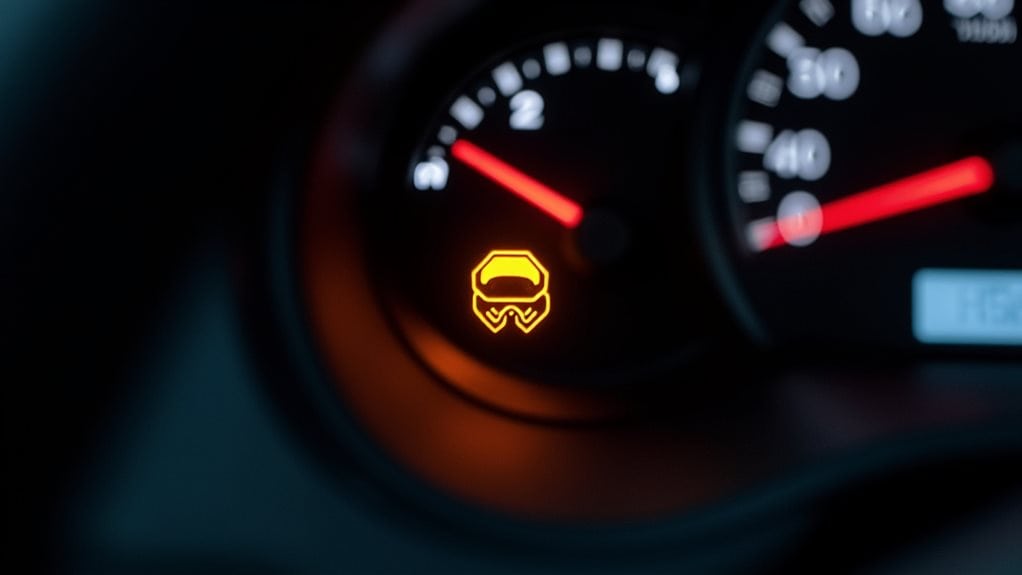
When you’re driving your Nissan Altima, the slip indicator light serves as an essential safety feature that’s part of your vehicle’s traction control system (TCS). You’ll notice this warning light, which shows a car with skid marks, illuminating when your vehicle detects wheel spin or loss of traction. The system works by monitoring wheel speeds and automatically adjusting engine power or brake force to maintain stability. The Powertrain Control Module receives data from sensors on each wheel to help regulate traction effectively, and maintaining proper tire pressure is vital for ensuring optimal traction and steering responsiveness.
Common Triggers for Slip Light Activation
Several distinct factors can trigger your Nissan Altima’s slip indicator light, ranging from environmental conditions to mechanical issues within your vehicle’s systems.
Wet or icy roads commonly activate the light, while faulty wheel speed sensors, worn tire treads, or brake system problems can also cause illumination. Additionally, a hard shifting issue in the transmission can lead to unexpected vehicle behavior, prompting the slip light to activate. You’ll often notice activation during rainy weather or when driving on slippery surfaces. A low brake fluid level can trigger the warning light to come on as it affects the system’s overall performance.
Recognizing Normal Vs Problematic Light Patterns
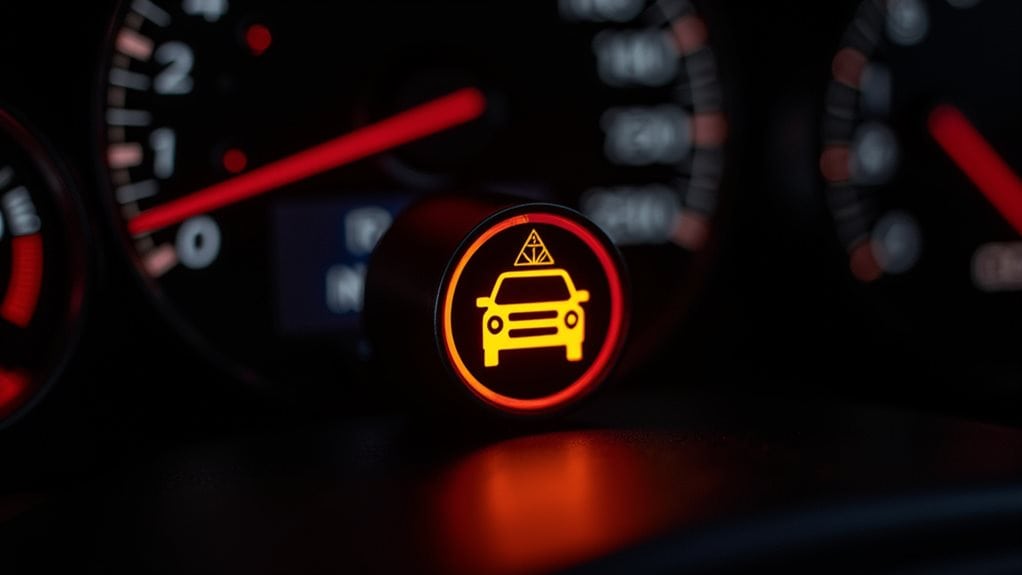
Your Nissan Altima’s slip indicator light follows distinct patterns that help you identify whether the system’s working normally or needs attention.
During normal operation, you’ll see brief flashes when the traction control activates on slippery roads, but if the light stays on continuously or flashes repeatedly during dry conditions, it’s time for a service check.
While the slip indicator works alongside other safety system lights, it specifically alerts you to traction issues, unlike the more general check engine light or ABS warning indicators. Maintaining proper refrigerant levels is crucial for ensuring optimal system performance and addressing potential issues.
Flash Patterns During Operation
The flash patterns of a Nissan Altima’s slip indicator light communicate essential information about the Vehicle Responsive Control (VRC) system’s operation.
When you’re driving, a flashing light indicates normal system engagement during slippery conditions, while a steady light suggests a malfunction.
You’ll notice rapid flashing during quick traction adjustments, whereas slower flashing signals less urgent system activity.
When Service Is Needed
While flash patterns help identify normal system operation, distinguishing between regular TCS activity and problematic signals can prevent unnecessary service visits.
You’ll need service if the slip indicator stays illuminated outside slippery conditions, your vehicle experiences reduced power, or the light activates frequently during normal driving.
Watch for issues with AUTO mode engagement or cruise control, as these can indicate system malfunctions requiring professional diagnosis.
Safety System Light Differences
Understanding modern vehicle dashboard lights can seem like decoding a complex puzzle of colors and symbols.
You’ll notice green and blue lights typically indicate normal operation, like your cruise control or high beams.
However, red and yellow lights signal potential problems that need attention, such as issues with your ABS, airbags, or engine systems.
How the Traction Control System Works

Your Nissan Altima’s traction control system relies on sophisticated sensors and a central control unit to monitor wheel speeds and road conditions continuously.
When the system detects wheel slip, it’ll instantly react by reducing engine power or applying selective brake pressure to maintain ideal traction.
These real-time adjustments happen within milliseconds, working seamlessly with your vehicle’s other safety systems to keep you stable and secure on the road. Additionally, the system’s effectiveness can be compromised by issues such as battery connections or faulty sensors, which may lead to unexpected power loss.
Core TCS Components
Traction Control Systems (TCS) in the Nissan Altima rely on several sophisticated components working in harmony to maintain ideal road grip.
Your vehicle’s wheel speed sensors monitor each wheel’s movement, feeding data to the Powertrain Control Module (PCM).
The system’s control module processes this information and works with the ABS module to adjust engine power and brake force when needed.
TCS Activation Process
The sophisticated TCS activation process in your Nissan Altima begins when wheel speed sensors detect a difference between the rotational speeds of your vehicle’s wheels.
Once detected, your car’s ECU quickly analyzes throttle input and road conditions, then responds by either applying brake force, reducing engine power, or adjusting spark timing.
In turbocharged models, the system may also decrease pressure to help regain traction.
Real-Time Response Mechanics
Building upon the sophisticated activation process, modern real-time response mechanics in Nissan Altima’s TCS work through a complex network of sensors and intelligent algorithms.
Your vehicle’s wheel-speed sensors continuously monitor rotation patterns, instantly relaying data to the ECU.
When wheel spin is detected, the system quickly responds by reducing engine power through throttle adjustment or applying precise brake force to specific wheels.
Immediate Actions When the Light Appears
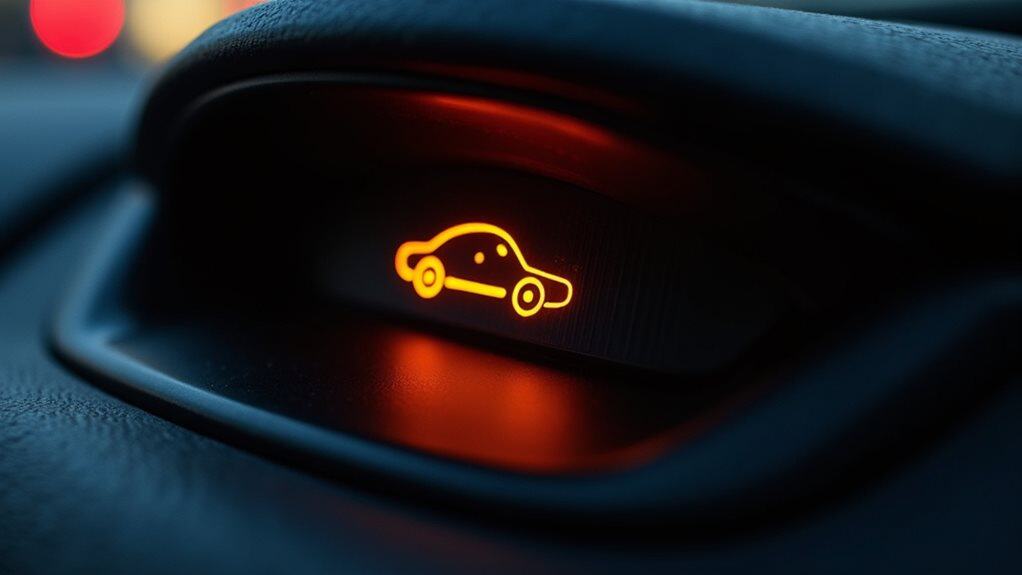
When your Nissan Altima’s slip indicator light illuminates, you’ll need to take immediate action to guarantee safe vehicle operation.
Reduce your speed gradually and avoid sudden movements or sharp turns.
Check your surroundings and road conditions while maintaining steady steering control.
You’ll also want to keep a safe following distance from other vehicles and stay alert until driving conditions improve.
Diagnosing Slip Light Issues at Home
You can start diagnosing your Nissan Altima’s slip indicator light issues by performing basic visual inspections of your tire pressure, brake components, and wheel sensors for obvious damage or wear.
Check your tire tread depth and pressure using a reliable gauge, as incorrect readings often trigger the slip light unnecessarily.
If these initial checks don’t reveal any problems, you’ll need to examine your vehicle’s wiring connections and use an OBD-II scanner to read any stored error codes that might point to specific system malfunctions.
Basic Visual Inspections
Before taking your Nissan Altima to a mechanic, several basic visual inspections can help diagnose why your slip indicator light is illuminated.
Start by checking all tires for proper inflation and tread depth according to manufacturer specifications.
Inspect the ABS rings and sensors for damage, verify your brake light switch position, and guarantee your wheels are correctly aligned to prevent traction loss.
Quick Diagnostic Steps
Several simple diagnostic steps can help pinpoint why your Nissan Altima’s slip indicator light remains illuminated.
Start by checking your tire pressure, as incorrect levels can trigger false readings.
Next, inspect your wheels for visible damage to the ABS rings.
You’ll also want to look for frayed wiring or loose connections near your wheel sensors.
Professional Diagnostic Steps and Solutions
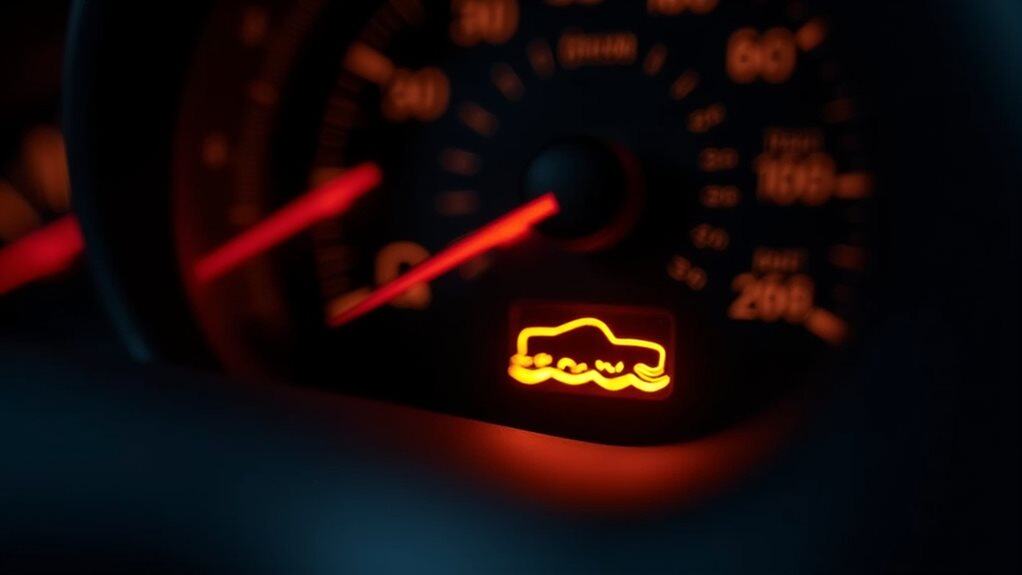
While diagnosing a slip indicator light issue in your Nissan Altima requires professional knowledge, understanding the systematic approach mechanics use can help you make informed decisions about repairs.
Professional technicians will scan your vehicle’s system for error codes using specialized diagnostic tools, inspect wheel sensors and ABS rings, and evaluate the brake switch and wiring connections.
They’ll also check your MAF sensor and ABS control module for potential malfunctions.
Impact of Weather on Slip Light Activation
Understanding how weather affects your Nissan Altima’s slip indicator light can help you anticipate and respond to system activations during challenging conditions.
You’ll notice increased slip light activity during rain, snow, and ice, as these conditions reduce tire traction.
When driving in adverse weather, slow down and avoid sudden movements, as slippery surfaces will trigger your traction control system more frequently.
Maintenance Tips to Prevent Slip Light Issues
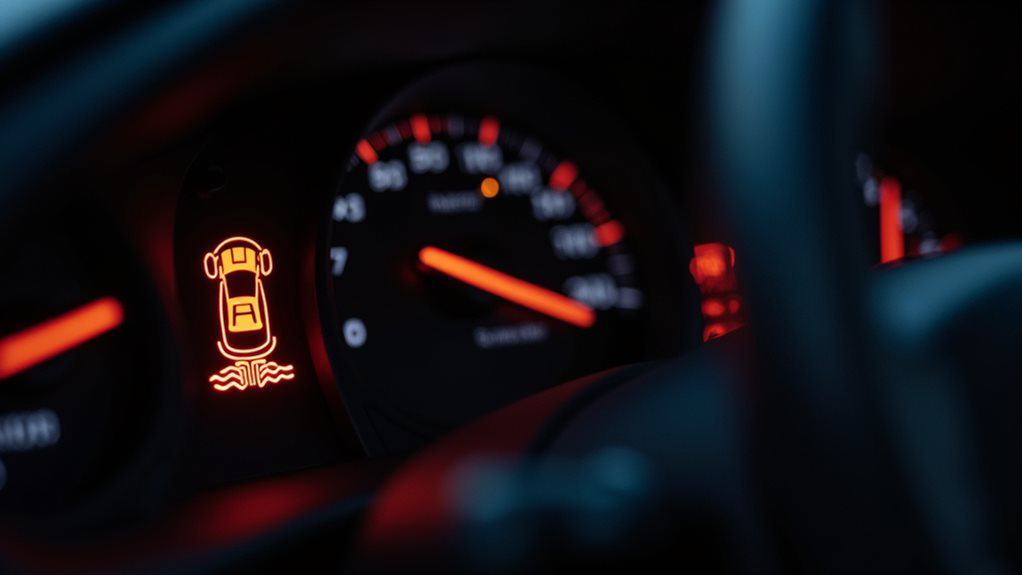
Proper maintenance of your Nissan Altima’s traction control system goes beyond just weathering the storm.
Regular inspections of ABS sensors, brake switches, and wiring connections will help prevent unexpected slip light activations.
You’ll want to maintain correct tire pressure, guarantee clean sensors, and keep brake fluid at proper levels.
Don’t forget to schedule periodic wheel alignments and sensor checks.
Warning Signs of Traction Control Problems
Early detection of traction control problems in your Nissan Altima can prevent more serious issues down the road.
Watch for warning signs like intermittent stalling, sudden jerking movements while driving, or reduced engine power.
If you notice your slip indicator light illuminating alongside the ABS light, or experience uneven power distribution to your wheels, it’s time to have your vehicle inspected.
Essential Safety Considerations
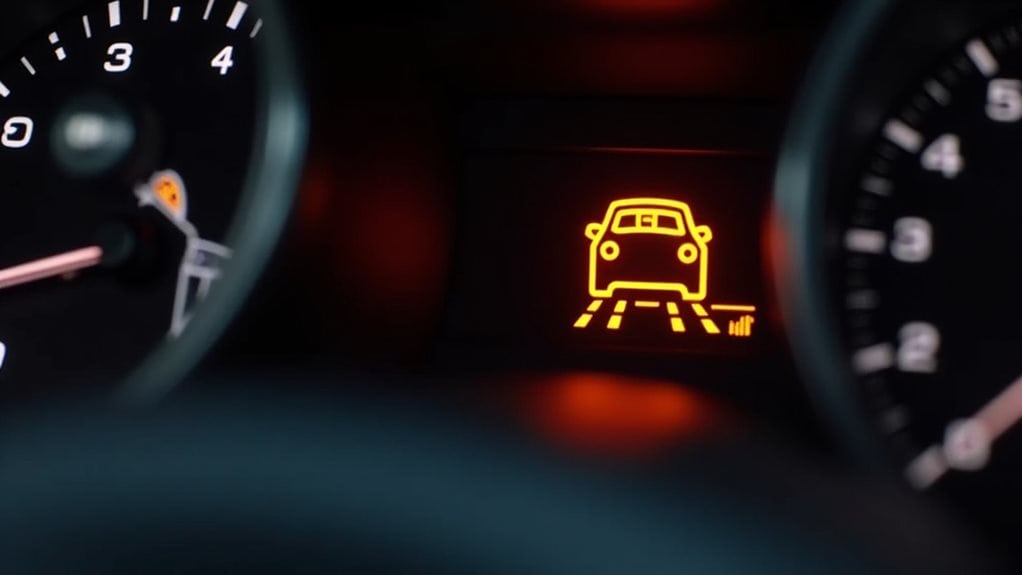
When your Nissan Altima’s slip indicator light illuminates, taking immediate safety precautions can help prevent accidents and maintain control of your vehicle.
Reduce your speed considerably and avoid sudden movements, including sharp turns or abrupt braking.
Be especially mindful of road conditions, as wet or icy surfaces require extra caution.
Always verify your tires are properly inflated and monitor your vehicle’s handling closely.
Long-term Care for Your Traction Control System
Long-term maintenance of your Nissan Altima’s traction control system extends beyond immediate safety responses to warning lights.
Keep a detailed repair log to track maintenance history, and schedule regular inspections to catch potential issues early.
You’ll need to monitor tire wear, maintain proper brake fluid levels, and guarantee wheel speed sensors stay clean.
Consider professional diagnostics for complex problems you can’t resolve.
Wrapping Up
Your Nissan Altima’s slip indicator light serves as an essential safety feature that shouldn’t be ignored. When it illuminates, you’ll need to assess road conditions and your vehicle’s traction control system. Remember to maintain regular servicing schedules, keep your tires properly inflated, and address any warning signs promptly. By understanding this system and following proper maintenance protocols, you’ll help guarantee your vehicle maintains peak traction and safety performance.

